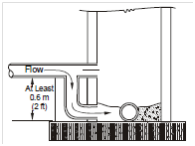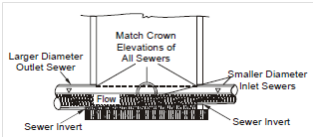Drop Manholes
When a sewer connects with another sewer, where the difference in level between water lines (peak flow levels) of main line and the invert level of branch line is more than 600 mm or a drop of more than 600 mm is required to be given in the same sewer line a drop manhole shall be provided. The outside connection is provided for the protection of man entering the manhole and resulting structure is known as drop manhole. Therefore, sometimes when a lateral sewer joins deeper, sub-main sewer, the use of a drop manhole will reduce the amount of excavation needed by allowing the lateral to maintain a shallow slope (Figure 9). The wastewater drops into the lower sewer through the vertical pipe at the manhole.

Figure 9: A Typical Drop Manhole Structure
Encasement of the entire outside drop in concrete or brick masonry is needed to protect it against damage during the backfilling of the trench. When such a drop gets plugged, a ball or a chain is dropped down to break any sticks, thereby permitting the plugging material to get washed out. Manholes should be built so as to cause minimum head loss and interference with the hydraulics of the sewer line. One way to maintain a relatively smooth flow transition through the manhole, when a small sewer joins one of a larger diameter, is to match the pipe crown elevations at the manhole (Figure 10).

Figure 10: Intersecting Pipes of Different Diameters at a Manhole